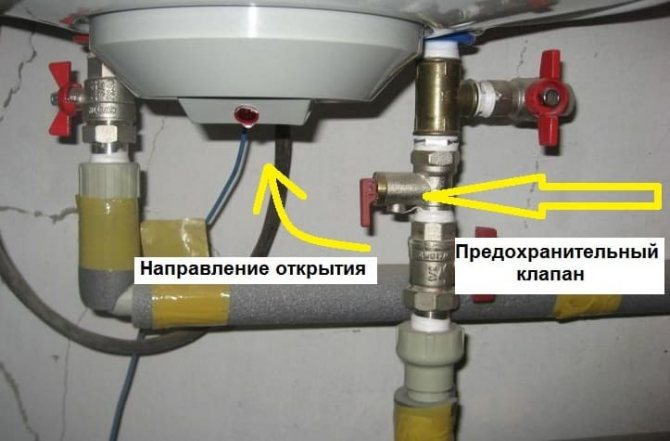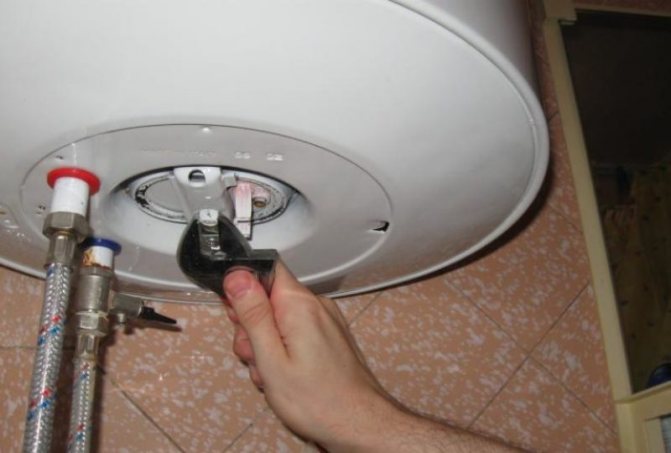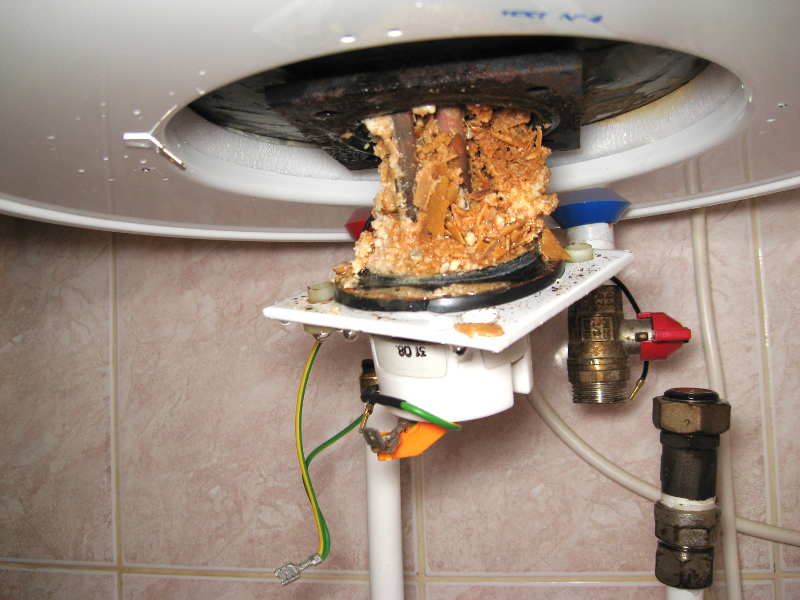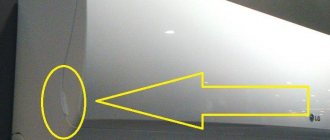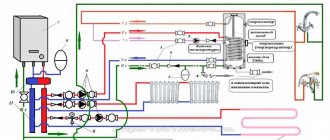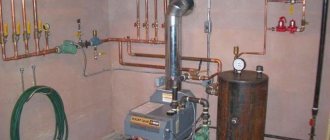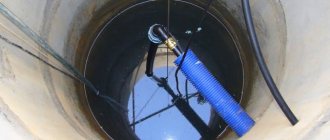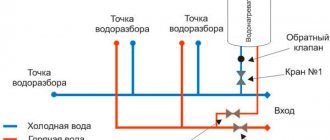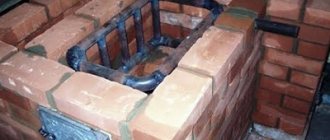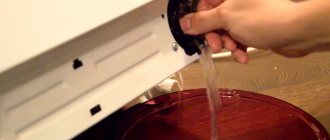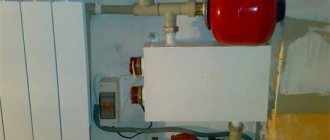It is a known fact that the quality of water in domestic water supply systems leaves much to be desired. Therefore, electrical household appliances in contact with hard water suffer from deposits of magnesium, calcium and lime salts. This problem is inherent in all water heaters. How to descale a heating element?
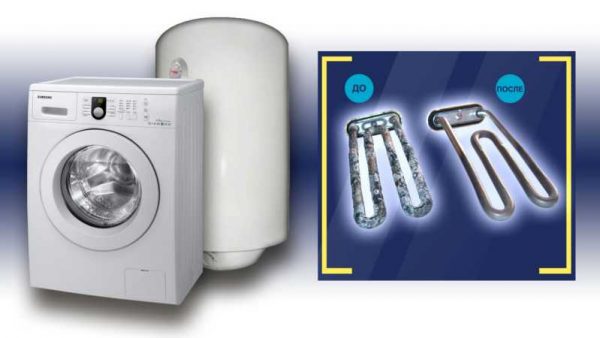
Limescale is a lime-salt deposit on the heating element, the inner walls of the boiler tank. It is formed during long-term, intensive use of the device. The hard lime layer has a low thermal conductivity. For this reason, energy consumption and water heating time increase. The efficiency of the water heater is reduced. Due to constant overheating, it fails.
Competently cleaning the heating element of the boiler, you can significantly extend its service life.
The water heater needs cleaning the heating element after 1-2 years from the date of the start of operation, for prophylaxis. If the water heats up slowly, energy consumption increases, the boiler is noisy, then the obvious reason for everything is lime scale. Over time, the plaque transforms into a thick crust on the element, which stops heat transfer. The protective relay is triggered, the boiler is turned off.
How to clean a water heater with your own hands without resorting to the services of repair shops? This is possible using mechanical and chemical methods. They are suitable for most models of various brands - "Ariston", "Termex", "Titan" and others.
How to properly drain the water and prepare the device?
Before starting cleaning, the boiler must be emptied of water. The easiest way to do this is if the device is located above the bathtub or a bulk container can be placed under it. Well, when the heating element is screwed directly into the tank, it can be pulled out at the same time as the liquid is drained. In some models, to remove the element, you have to unscrew numerous nuts, then we empty the boiler in advance.
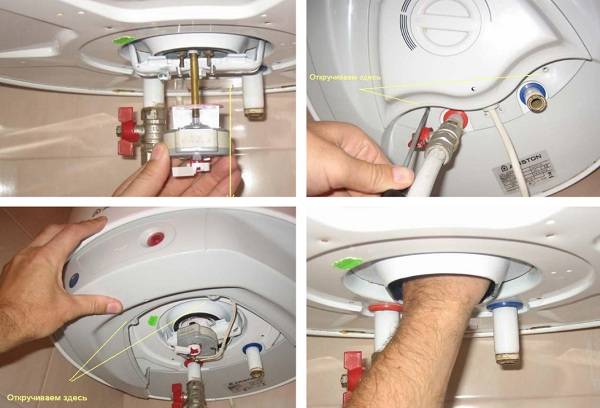

The water drain algorithm always looks like this:
- Disconnect the device from the network and turn off the water supply tap (on the pipe).
- We turn off the tap, which is responsible for supplying cold water, located near the heater. After that, we start up the water on the nearest mixer so that the glass is hot.
- We attach a tube to the drain fitting, direct it to the sewer, drain the water by opening the tap.
In the absence of taps and fittings, all liquid can be drained through the safety valve. The main thing is to act carefully and consistently so as not to burn yourself and not to provoke an accident.
Necessary tools and tools
Boiler with dry heating element
A boiler with a "dry" heating element is easier to clean - it will be enough to clean the tank, since the heating element itself is isolated from direct contact with water. Constructions with a conventional heating element, in principle, are cleaned for the same amount of time, but sometimes it is better to disassemble the boiler and remove the heating element in order to better clean it.
At home, it is easier to act according to a method that does not require disassembling the water heater. For this, it is recommended to use a weak acid (citric or acetic). The cleaning process is carried out in several stages:
- Connect the hose to the branching unit and clamp it with a clamp for a snug fit. In this case, the hot water valve should not be closed.
- Drain some of the water from the tank by closing the valve through which water is supplied to the tank. In large boilers (100 liters or more), 30% of the liquid is drained.
- Make a solution of citric acid in hot water at the rate of 250 g per 1 liter.
- Pour the solution into the tank through the hose. For this, it is convenient to use a watering can or funnel. In order for the water to flow easily from the watering can into the tank, it must be located above the water level in the tank (according to the principle of communicating vessels). Water drainage taps must be closed.
- Then open the cold water valve to fill the tank and connect the boiler to the electrical network.
- The boiler starts to work. After he heats the water to the set temperature, he must be left for several hours so that the liquid dissolves the scale.
- After that, it is necessary to empty the tank and refill it, and then empty it again. Repeat this procedure 2-3 times.
If after a short period of time the boiler starts to operate as it did before cleaning, it may be necessary to replace the magnesium anode. The fact is that it is designed to minimize the appearance of rust and scale, as it pulls cations onto itself so that the heating elements and tank walls do not deteriorate for a long time. But over time, of course, it itself becomes unusable and ceases to fulfill its immediate function. After replacing it, the device will work normally again.
If it is not possible to clean the structure yourself, it is recommended to call a specialist.
It is better to clean the flow-through water heater chemically. Disassembly is not required. To do this, you need to disconnect it from the network and pour the same solution through the tube as in the boiler. Taking into account the fact that plaque settles in pipes more slowly, its layer will be smaller, and the pipes will be cleaned faster. The reservoir of the flow-through structure itself is also smaller, so it will be enough to interrupt its operation for only 2-3 hours. After that, it is recommended to drain as much water as possible so that all dissolved sediment flows out of the pipes.
When to clean the water heater
Interruptions in the operation of a water heater begin 2-3 years after the start of its operation. The heating element located in the storage boiler is covered with a layer of lime that increases in thickness day by day.
The following signs also indicate the need for cleaning:
- increased heating time and, accordingly, power consumption;
- the device emits uncharacteristic extraneous sounds, most often hiss of varying volume;
- the water has acquired a yellowish tint;
- a characteristic hydrogen sulfide smell emanates from the water;
- yellowish flakes are visible in the water - pieces of scale;
- the outer walls of the tank began to overheat.
If the water in the apartment has a hardness of more than 350 mg / l, it is recommended to clean the heater annually. In some areas, the water is so hard that scale accumulates on the heating element in 5–6 months, and it must be cleaned.
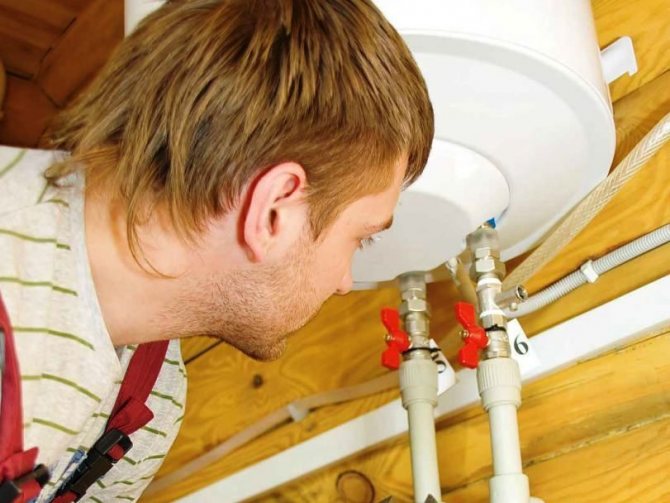

Prevention of limescale
Depending on the frequency of use, the boiler should be cleaned at different intervals. If it is in the apartment, cleaning once a year will be sufficient. If the water heater is installed in a cafe or in production, it should be descaled every six months.
If preventive cleaning is not carried out in a timely manner, the device will gradually spend more and more time on heating the water. In the future, the spiral will bend from scale and completely stop heating the water. In this case, you will have to replace the heating element with a new one.
In order for scale to form less often, the boiler should not be used at the highest temperatures. Additional filter installation also helps.
The video describes in detail the issue of cleaning the heating element of the water heater from scale:
Removing the flange
The heating element is attached in different ways, depending on the manufacturer. In Ariston boilers, you need to unscrew the fastening nut with a 13 key and remove a small metal corner. The cover with the heating element must first be inserted inside the tank. If this cannot be done easily, you need to knock and loosen the lid.The heating element inside the boiler is turned over and taken out sideways, since it is bent.
We recommend: Self-measurement of air humidity at home
In some models of Ariston water heaters, the heating element is unscrewed counterclockwise (how to disassemble an Ariston water heater to change the heating element, read this article). This is indicated by the key edges on the brass part of the flange. At Termex and Atlantik, you need to unscrew the nuts around the circumference and remove the fastening washer. Then the flange is pulled down.
It is important to carefully pull out the flange as the coil may be too much scaled up. The heating element is removed carefully and slowly with shaking movements.
Disassembly and disconnection
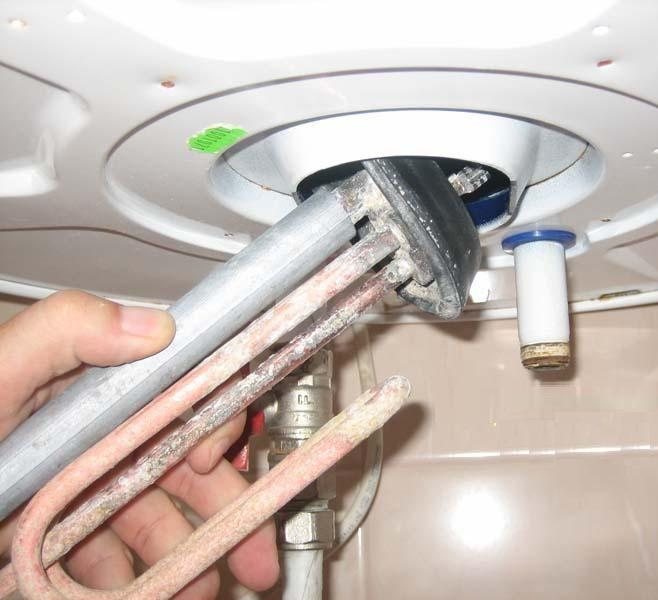

When the water is drained, you should partially disassemble the device and pull out the heating element. The protective cover from the bottom of the boiler is removed first. It is attached with screws that must be unscrewed with a Phillips screwdriver. Some bolts may be covered with protective stickers. After unscrewing the screws, the cover can either be easily removed, or you will need to pry it off to remove it from the latches. In Gorene boilers, the lid is fastened only with latches, you do not need to unscrew anything.
Further, the power wires and light bulbs are disconnected.
It is important to remember the wire connections. Usually, the blue wire indicates zero, the yellow-green ground (it is sometimes attached to the case itself), and the brown or black phase. On the device itself, the letter "L" denotes the phase, the letter "N" - zero. To be on the safe side, you can draw a simple diagram or photograph the wires.
The thermostat is removed next. To do this, pull it down.
Draining water from the boiler
Before you start cleaning the device, you need to drain all the water from it. This is the most important rule that must be followed unquestioningly before starting repair and cleaning work.
If the boiler is located above the bathtub or sink, then this position of the device makes it much easier to drain the water. You do not have to select a suitable container, install it. And the spray will be several times less. However, not all devices make it easy to drain water, even with the above conditions.
If the heating element is screwed into the tank, then the drain will be easy. But there are some models in which, before getting to the stage of draining the liquid, you will have to unscrew a few nuts.
With the correct installation and connection of the boiler, there should be no problems immediately after the purchase. Need to act in a certain way.
- Disconnect the power supply from the device, turn off the main water supply tap. Do the same with the tap located next to the water heater.
- Open hot water on a nearby mixer and wait until it is completely drained.
- Put a hose on the drain nipple and direct it to the drain hole to drain the water.
If there are no drains and taps, the water is drained through the safety valve. But this is a very long process. Therefore, you should first wait for the liquid to cool completely.
The absence of a union is due to the need to drain by dismantling the hot pipe and completely disconnecting it from the water heater. After unscrewing the safety valve, air will enter the boiler, pushing the water out.
This method will solve the problem of quickly draining water from the device.
Why is scale in an instantaneous water heater dangerous?
In addition to the fact that visually solid sediment is dirt, it also has a more harmful property, due to which the removal of scale from the water heater is necessary. The thermal conductivity of the solid sediment is extremely low. Therefore, covering the metal structure of the heating element, the sediment forms an insulating layer. This layer with poor thermal output significantly reduces the temperature of the heating device and, accordingly, prolongs the process of heating the liquid in the tank.
The temperature conductivity level of the sediment is tens (and even hundreds) times lower than that of the metal from which the element that heats the water is made. Due to the temperature drop, the metal can deform, holes and cracks can form on it. Obviously, in this case, the device fails. Therefore, it is better to remove scale in the water heater in time than to lose a working water heater and start figuring out how to replace the heating element.
Assembling the heater
The assembly must be carried out in the reverse order to achieve operability, in case your device has lost functionality, it means that you did the assembly incorrectly. Consider the rubber part; there should be no cracks, plaque or other damage on it, if any, it is imperative to replace it. The rest of the rubber parts must be coated with sealant to protect the boiler from leaks. Next, we fix the electric heating element in its original place, do not forget to screw in the grounding and connect all the contacts back.
Fill the tank by first opening the hot water tap and then cold water. After the boiler is filled, check its tightness, whether there is any water leakage somewhere. If everything is ok, finish the assembly - connect the thermostat, connect the panel, screw the cover. The cleaning procedure is complete, you can turn on the power supply. The boiler is ready for use.
Chemical cleaning of the hot water appliance
The simplest ways how to descale a water heater without disassembly should be known to every owner. Timely preventive maintenance will prevent the deposition of thick stone layers, and the boiler will not have to be disassembled.
Cleaning with a solution without disassembly
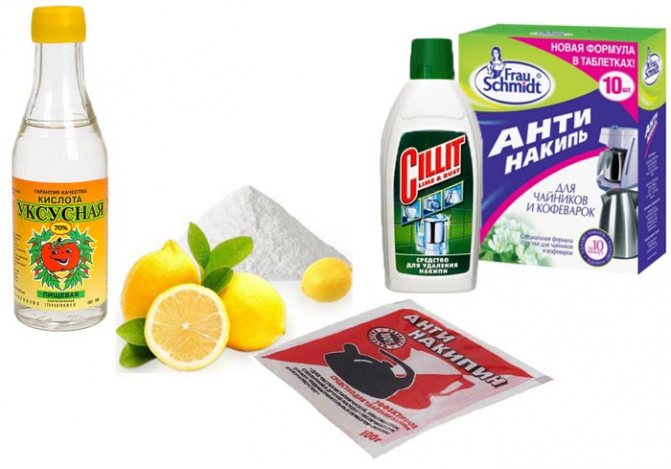

The method of descaling from a boiler is based on the use of a cleaning solution prepared from water with the addition of vinegar or citric acid. When limescale gets into an acidic environment, a chemical process begins, destroying the scale. Store-bought cleaning products work in a similar way. The only question is how to pour the solution into the boiler. And to do it is simple:
- turn off the cold water supply tap, and then disconnect the water pipe from the inlet pipe on the boiler;
- on the mixer, open a tap with hot water and drain about 2/3 of the liquid from the tank;
- the hot water tap is closed, and a hose is wound onto the inlet pipe of the boiler;
- a watering can is inserted into the second end of the hose and, lifting it above the boiler, the cleaning solution is poured.
With a cleaning solution, the boiler costs 5–6 hours. After the time has elapsed, the dirty liquid is drained by opening a hot water tap on the mixer. The tank is flushed with cold water supply from the water supply.
In order not to drive dirty liquid through the pipeline to the mixer, an additional drain valve is brought out on the boiler branch pipe.
Cleaning solution with disassembly
When running, scale layers fall off from the inner surfaces of the water heater. It will not be possible to remove them chemically without disassembling. The boiler must be removed, unscrew the flange with the heating element from below and remove solid layers from the tank with your hands. After manual cleaning, a cleaning solution is poured into the tank. The heating element is put in its place. After 5–6 hours, the dirty liquid is drained, the boiler is washed and attached to the wall.
How to drain water from a boiler: instructions
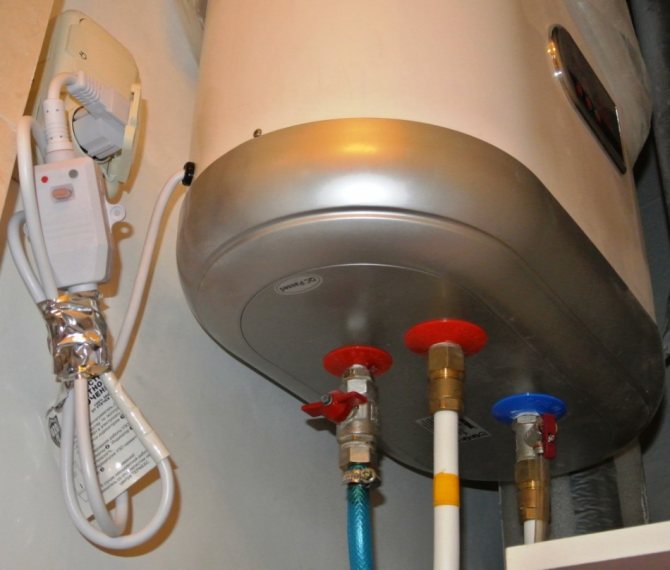

Boiler water supply taps
Disassembling and cleaning the electric tank is not difficult, but the device itself is heavy. Therefore, it is better to remove it with another person who will help and support the device during dismantling. Here are instructions on how to drain the water from the boiler:
- Disconnect the device from the mains, remove the plug from the socket.
- Disconnect the cold water hose from the water pipe and lower it into any container (basin, bath, and so on). The hot water pipe does not need to be touched.
- Put the hose that you removed over the safety valve. Dip the free part of the hose into a container.
- Open the taps of the device, and release the check valve fuse.
- Open the hot water taps in the bathroom and kitchen. First, you will hear a sound as if the tank is drawing in air, and then the liquid that was in the device will be ejected. For this, it was necessary to lower the hoses into the container.
- After all the liquid has drained out, blow out the cold water hose with air. If there is no gurgling, you can continue on.
We recommend: How and how can you remove stickers from the refrigerator in a few seconds?
Now unscrew the hose that supplies hot water to the mixer. Remove the boiler from its place and place it on the floor with the taps up. Proceed to the next step of dismantling.
Step by step instructions
Draining water from the boiler
The first thing to do is to drain the water heater. To do this, you need to use the safety valve on the cold water supply, if it has a manual release handle, or turn off the hot water valve, then unscrew the armored hose from the cold water supply (subject to soldering, a transitional American) and open the second valve.
A boiler with a volume of 80 liters is emptied through the safety valve for 3 hours. In all other cases, the water flow is regulated manually by a previously pre-installed valve.
Removing the protective cover and disconnecting the temperature sensor supply
This will require a curly screwdriver. After unscrewing all the screws from the lid, the main mount will open to the seat of the heating element and access to the inside of the tank. As soon as the mount is dismantled, overcoming the force of the sealing rubber, the heating element itself is removed, on the case of which a magnesium anode is installed.
Dismantling the tank
After all the above steps, the tank is removed from the wall. This is necessary for a more thorough self-service and high-quality cleaning under running water from accumulated dirt and salt deposits.
As soon as the tank is on the ground, a bucket of water is poured into it, after which the entire container is washed with a regular rag, and so on several times. After the surface deposits have been removed, you can proceed to the treatment of the surfaces affected by scale using one of the mentioned means. It is enough to follow the instructions and also avoid products that contain phosphates.
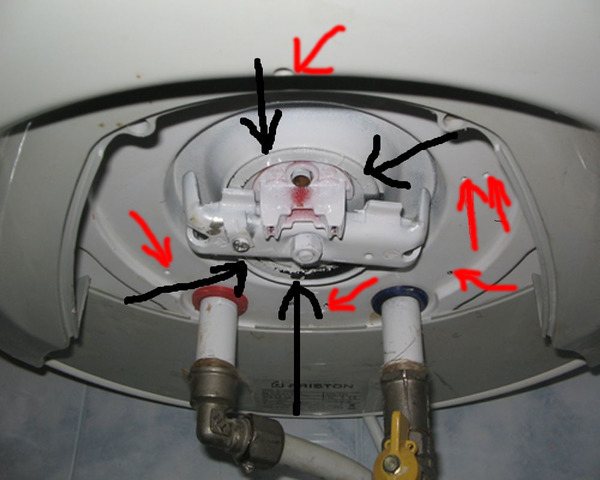

Descaling the heating element
The largest amount of scale deposits is always concentrated on the walls of the heating element, simultaneously destroying the anode. After removing scale from this functional block mechanically, the remnants of the magnesium anode are removed to install a new one (replacement is mandatory).
As for the heating element itself, for its complete cleaning, you will need to pick up any container, fill it with a previously used descaling agent, but at the same time exceeding the concentration by 3 or more times. The heating element is lowered into the prepared solution for the next 3-4 hours.
If you can't wait 3 hours, you can warm up the liquid solution or bring it to a boil altogether. An old electric kettle is also suitable for this. The fumes are extremely toxic, so you need to protect the respiratory system or leave the room altogether.
Such simple manipulations will help to completely get rid of scale in the shortest possible time, while returning the boiler to its previous efficiency and energy savings.
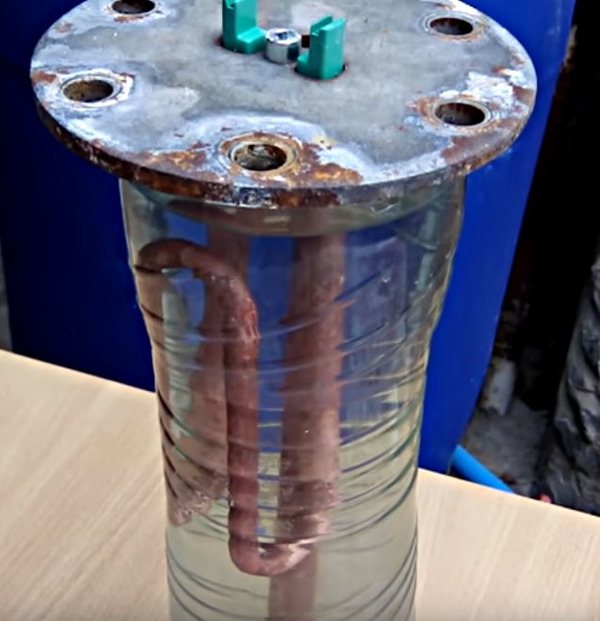

Mechanical method
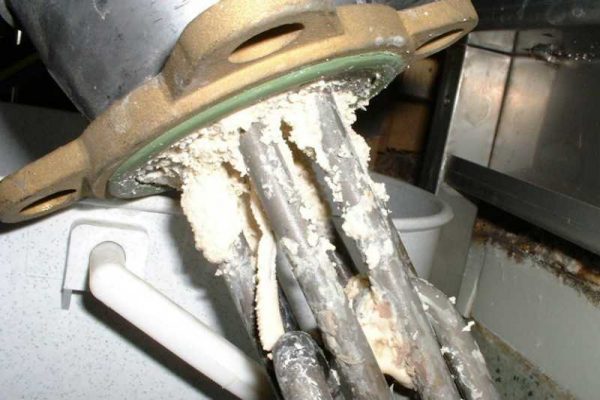

The solution to the problem (how to clean the boiler mechanically) conditionally consists of the following steps:
- disconnecting the device from voltage;
- removing water from the tank. Turn off the general water supply valve and the valve supplying water to the tank. Put a hose on the drain connection, drain the water into the sink, toilet.
- Cleaning the heating element. After removing the water, dismantle the tank pan by unscrewing the fastening screws.We remove the control board by freeing the wires. We remove the teng from the tank. Depending on the model of the water heater, the sequence of actions is adjusted. It is better to take step-by-step photographs of disassembly in order to then assemble the device in the correct sequence. We perform mechanical cleaning of the heating element immediately, while the lime crust is wet, using a metal brush, knife, wooden spatula. Finish cleaning with emery cloth. It must be remembered that the degree of its heat transfer depends on the quality of cleaning the heating element.
- Cleaning the inner walls of the boiler. To remove scale from the inside of the boiler, you just need to gently wipe the walls with a damp cloth. It is unacceptable to use abrasive products in order to avoid damage to the inner enamel coating. Actually, this point is controversial. Professionals say that the lime-salt layer on the walls of the tank protects the metal from corrosion, serving as additional thermal insulation for the hot water in the tank.
- Assembly and connection. Reassemble the device in reverse order. All electrical wiring must be dry. It is imperative to check the tank for leaks - fill it partially with water, observe it for a day. If the leaks are not fixed, you can fill the water heater completely with water, connect it to the network.
Cleaning electric water heaters
The cleaning process is very simple. The scale is removed from the walls of the tank and other parts with a regular cloth. For greater efficiency, dismantle the removable water heater and rinse it with water.
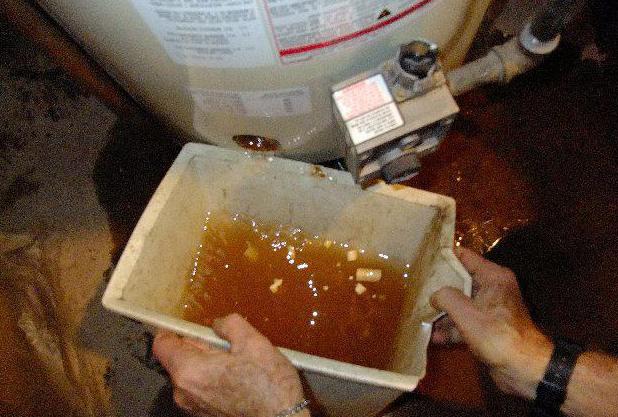

Boiler flushing
It is especially necessary to carefully remove plaque from the surface of the heating element. If you press hard, you can deform its structure. To clean it, use sandpaper or a metal brush.
It happens that the heating element cannot be cleaned. Heavy contamination usually occurs if the appliance has not been cleaned for more than two years. In this case, only replacing the heating element with a new one will help. It is worth carefully choosing a new part, it must exactly fit in size, power and method of connection with the main device.
When cleaning, check the magnesium anode. It should be replaced if it is worn out and becomes less than 20 centimeters.
The water heater can be installed back according to the diagram below. All these steps must be performed in the reverse order. It is advisable to check all connections for leaks after installation.
So that cleaning the water heater does not turn into a breakdown, it is worth remembering:
- Do not descale the inside of the boiler using sharp and hard objects. They can scratch the enamel coating and the tank will start to rust.
- It is better not to touch the magnesium anode with bare hands.
- All wires must be connected correctly. The voltage supply can only be started after the assembly is completed and the container is filled with water.
After installing the boiler, you need to observe its work. And also pass through it from 50 to 100 liters of heated water to rinse the inside.
Tips for disassembling the structure and cleaning the wet heating element
Before cleaning the boiler begins, the device must be disassembled by pulling out the heating element. To do this, first remove the decorative plate that covers the contacts and the place where the element is attached. It can be screwed on or latched on. Having reached the internal elements, it is recommended to photograph them so that there are no problems with the subsequent recovery of the system.
We disconnect all contacts, after which we take out the heating element. If the device has not been descaled for a long time, proceed very carefully. Accumulated dirt may prevent the heating element from being easily removed. You do not need to pull it, it is better to try to carefully clean the deposits.
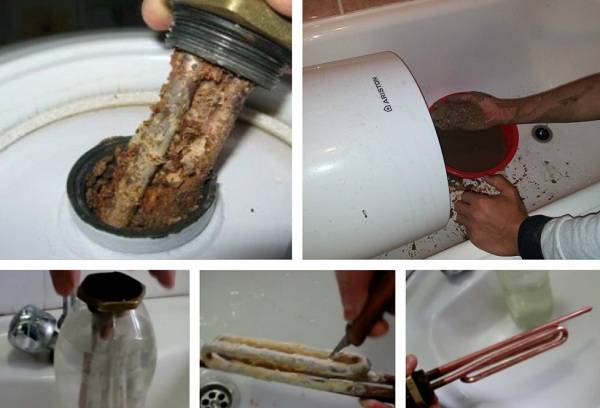

Tip: Having reached the insides of the structure, it is recommended to assess the condition of the magnesium anode. If it is severely thinned, then it should be replaced without waiting for the element to fail.
In most cases, scale layers are collected on the tubular part, and there is not much of it inside the tank. It is enough to turn on the water to wash everything unnecessary from the boiler itself. If you cannot clean the boiler in this way, you will have to work with your hands. The main thing is not to try to facilitate the process by using aggressive abrasives. You need to use only proven safe means.
To clean the heating element itself from the scale layer, it is necessary to carry out the following manipulations:
- We clean off the main part of the dirt mechanically using a knife or something similar.
- Next, dilute citric acid in a tall glass made from a plastic bottle (just cut off the neck). For 2 standard sachets of powder, about 2 liters of warm water.
- We place the heating element in this structure for at least a day. This time will be enough for all the dirt to come off, and the heating element returns to its original form.
Recommended: 7 ways to hide pipes in the bathroom
After carrying out these manipulations, you can assemble the boiler, test it and subject it to further operation.
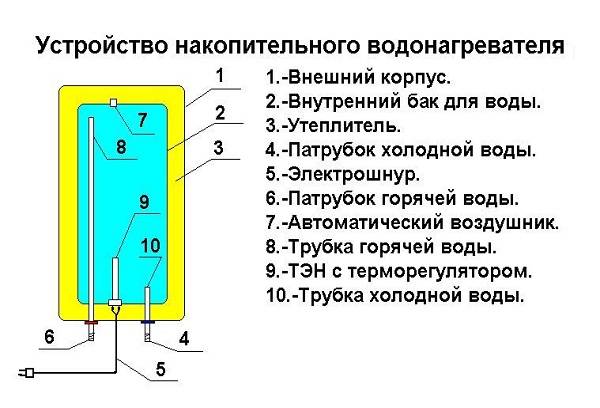

Cleaning products
It is possible to remove scale from the heating element of the water heater with the help of improvised and professional chemicals.
Folk
Some substances that every housewife has at hand can dissolve scale and restore the operation of the boiler:
- Vinegar. 5 tablespoons of vinegar (9%!) Or 2 teaspoons of the essence are diluted in a liter of water.
- Citric acid - 50 grams per liter of water.
Professional
All products contain acidic and alkaline components that can completely remove scale, rust and other contaminants from the heating element.
The following preparations are most popular for cleaning the boiler:
- Filtero;
- Topperr 3031;
- Bagi Kumkumit;
- Melon ZhS17;
- Silith;
- Eon Bio;
- Bagi Shumanit;
- Solita;
- Boiler Master.
The selected chemical should be used strictly according to the instructions. Before use, an aqueous solution is prepared from them. Violation of the concentration of the highly acidic solution and the time of its exposure will lead to the failure of the boiler.
Draining
Water draining takes place in several main stages:
- We close the water supply valve in the apartment.
- The easiest way is to drain the water from the water heater through a non-return valve. To do this, connect a hose to it, direct the other end to the bathroom or toilet and open the valve. You can simply substitute a bucket from below and pour water out of it from time to time.
The disadvantage of this method is the long drainage time. It can take up to 4 hours to drain 100 liters of water from the boiler through the valve. - You can drain the water faster by unscrewing the water outlet from the boiler and removing the valve. After that, a hose is connected to the outlet from the water heater and the branch pipe is gradually unscrewed from the inlet to the boiler. Thus, air can enter the tank, and the water will drain out in a few minutes.
Limescale, which is located at the bottom of the tank, can interfere with the water drain. In this case, you need to move it to the side by thrusting a screwdriver into the hole from which water is pouring.
Boiler assembly
The heating element, cleaned of scale, is pushed back into the tank and fixed. Water pipes, check valve and electrical wires are connected. It is important to make sure that the tank is filled with water before plugging in the water heater. Otherwise, the heating element can burn out very quickly.
In order for water to accumulate, we turn on the valves for the inlet and outlet of water from the boiler and a hot water tap. First, air will come out of it and liquid will flow over time. The boiler and pipe connections are inspected for leaks (how to fix a leak in the boiler, read this article) and then the protective cover is put in place.
When should you clean?
Before you start cleaning a water heating unit of any brand - "Atlantic", "Oasis" or another - it is worth analyzing the operation of the product, listening to the noise and checking the quality of water heating.
The main "bells" signaling that it is time to clean the product are the following factors:
- water heats up for a very long time;
- her temperature has changed - it has become too hot, or vice versa;
- the amount of electricity consumed by the boiler increased, and the meter began to wind off kilowatts many times faster after starting the device;
- overheating of the storage tank;
- in case of frequent switching on and off of the device;
- if a hissing sound is heard from the boiler while heating the water.
Choice of funds
Cleaning the boiler, for example, Ariston, will be much more effective with the availability of special equipment. Visit a household chemicals store, where you will definitely find a product for cleaning. Just do not forget to find out if this tool is right for you, because some chemical reagents may not be suitable, for example, to a rubber seal, they can ruin it.
As mentioned earlier, a good cleansing result is obtained using a saturated solution of citric acid (sold in sachets). To use it, take half a kilogram of the substance and dissolve it in 2 liters of water (preheat it so that the acid is completely dissolved).
What is meant by the boiler cleaning procedure
To figure out how to clean boilers without calling the master, you need to learn how to disassemble them. All electric water heaters are designed in almost the same way. The methods of fastening the heating element and the electronic unit may slightly differ. The second important point - you need to know how and how to clean the water heater. There are two methods:
- Dry cleaning. The boiler does not have to be disassembled. It is enough to use a special factory-made descaling liquid. From folk methods, a concentrated solution of citric acid is suitable.
- Mechanical cleaning. A complex method that requires disassembling the water heater. First of all, heating elements are overgrown with a bloom in storage boilers. First you need to clean the heating element and then rinse the tank.
The mechanical method is justified when dry cleaning of the water heater has not brought positive results.
Before proceeding with the cleaning of the electric boiler, the device is disconnected from the water supply system, the electrical network and water is drained from the tank.

